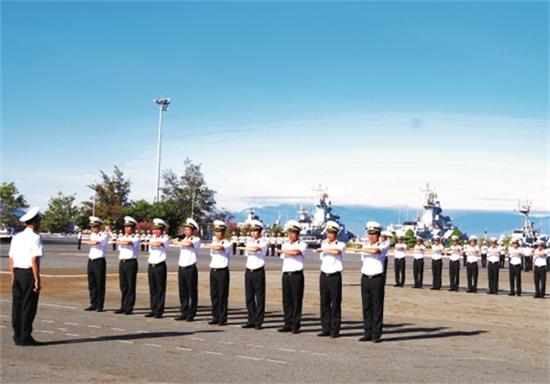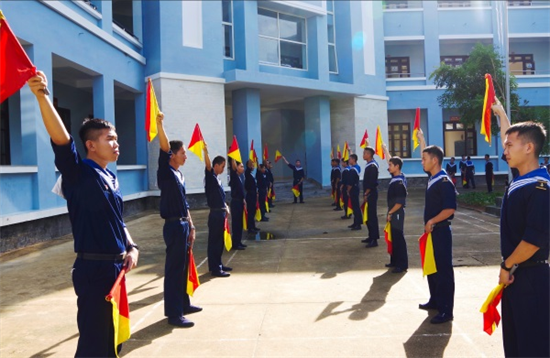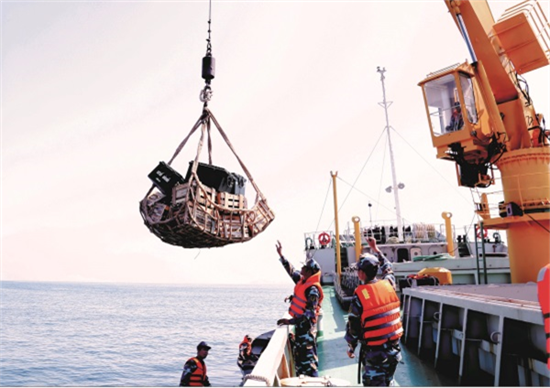Upholding the 50-year tradition of construction, combat, and growth, the Party Committee and Command of Naval Region 4 have consistently and proactively implemented comprehensive measures to build the Region into a revolutionary, regular, elite, and modern force, continuously enhancing its overall quality and combat capability. The Region truly deserves to be recognised as a core force of the Vietnam People’s Navy, entrusted with the mission to manage and firmly defend the sacred sovereignty of the Fatherland’s seas and islands.
In response to the urgent requirement of firmly safeguarding national maritime sovereignty, immediately after national reunification, on 26 October 1975, Naval Region 4 (formerly Coastal Region 4) was established. Throughout five decades of construction, combat, and maturity, generations of officers and soldiers of Naval Region 4 have upheld the spirit of solidarity, determination to fight and win, and the heroic tradition of the Navy. They have recorded numerous outstanding achievements in the protection of the sovereignty over the South Central Sea, the Truong Sa (Spratly) Archipelago, and in ensuring the absolute safety of the Cam Ranh Military Base.
 |
| Conducting training on shore |
In recent years, facing the increasingly complex developments in the East Sea (South China Sea), the Region has always maintained a firm grasp of the situation, heightened vigilance, and closely coordinated with other forces. It has actively advised the Navy Command, the Central Military Commission, and the Ministry of National Defence on various policies and measures to build defence potential and a solid maritime defence posture in the Truong Sa Archipelago, as well as on timely and effective responses to situations at sea and on islands, avoiding passivity or surprise. At the same time, the Region has effectively implemented the goal of building itself to be an “elite, compact, and strong” force moving toward modernisation; striving toward the standard of a “comprehensively strong, exemplary, and typical” unit. Its overall quality and combat strength have continuously improved, affirming its position as a core force in safeguarding assigned seas and islands, and in developing the Truong Sa Special Zone into a firm fortress, capable of protecting the Fatherland early and from afar. With its outstanding achievements, the Region has been honoured with numerous noble awards and decorations by the State, the Ministry of National Defence, and the Vietnam People’s Navy.
Having achieved those proud results, Naval Region 4 has been resolutely implementing various guidelines and measures to successfully realise the goal of building the Region into a revolutionary, regular, elite, and modern force.
Firstly, the Region concentrates on strengthening its political foundation, preserving the revolutionary nature of its officers and soldiers, who are always ready to fight and sacrifice for the sovereignty and security of the Fatherland’s seas and islands. Along with improving the leadership capacity and combat effectiveness of Party organisations at all levels, the Region directs all agencies and units to effectively implement Directive No. 2423-CT/QUTW dated 9 November 2023 of the Central Military Commission’s Standing Board on “Renovating and improving the quality of political education in the new period.” In this process, it actively renews content, form, and methods of education, applying creative and practical models suited to each type of unit; focusing on traditional, task-oriented, and legal education, as well as on raising awareness of partners, adversaries, and hostile schemes at sea, under the guiding motto: “One reduction, one increase, three realisms, and two closenesses and two enhancements.” Concurrently, the Region effectively implements Conclusion No. 01-KL/TW dated 18 May 2021 of the Politburo (13th tenure) on continuing to implement Directive No. 05-CT/TW (12th tenure) on “Promoting the study and practice of Ho Chi Minh’s thought, morality, and style”; and Resolution No. 847-NQ/QUTW dated 28 December 2021 on “Promoting the qualities of Uncle Ho’s soldiers and resolutely combating individualism in the new situation.” It also carries out the campaign “Promoting tradition, devoting talent, deserving to be Uncle Ho’s soldiers – Naval Soldiers in the new era.”
 |
| Training on signaling |
To address ideological issues among troops, especially those stationed on islands, warships, and isolated units, the Region directs strict implementation of the Regulation on Ideological Management in the Vietnam People’s Army, and ensures effective orientation and guidance of internal public opinion. It also enforces the Grassroots Democracy Regulation, fostering unity and mutual trust within units. The Region adheres to the principles of being close to the troops, understanding the troops, and trusting the troops, to proactively grasp, manage, and guide their thoughts. Positive examples are widely promoted by “using the good to dispel the bad, using the positive to drive out the negative.” As a result, 100% of officers and soldiers maintain firm political ideology and resolve, overcome hardships, and remain fully committed to their missions, considering “ships and islands as home, and the sea as homeland.” They remain vigilant against all hostile schemes and ready to fight and sacrifice to defend the Fatherland’s maritime sovereignty.
Secondly, promote the restructuring of forces to become elite, compact, and strong, in close association with building an integrated, solid, and in-depth coastal-marine-island defensive posture. The Region strictly implements resolutions and decisions on force structure and organisation, reviewing, adjusting, and consolidating its components according to the new organisational model, ensuring that they are streamlined, strong, balanced, mobile, and highly ready for combat. Units are required to reduce redundant personnel in intermediate and service departments, while prioritising sufficient strength, weapons, and technical equipment for combat-ready forces, particularly those deployed on islands, radar stations, and warships equipped with modern technology. To establish a comprehensive, interconnected, and in-depth defence posture, the Region conducts thorough research and evaluation of the deployment of forces, proposing to the Navy Command adjustments to the distribution of forces onshore, at sea, and on islands or island clusters, especially in key maritime areas.
This ensures tight coordination between stationed and mobile forces, suitable for both peacetime patrol and control operations and for wartime combat plans to defend the sea, islands, and bases in new conditions. Additionally, the Region directs units to coordinate with localities in building strong maritime militia and reserve forces, with appropriate structures and mobilisation plans to participate in defending maritime sovereignty and support fishermen to maintain offshore presence, thereby consolidating the all-people national defence posture and the “people’s heart and mind posture” at sea.
Thirdly, prioritise raising the quality of training, exercises, and combat readiness. This is regarded as the core solution to enhancing the Region’s operational capability and response to emerging situations. The Region strictly implements Resolution No. 1659-NQ/QUTW dated 20 December 2022 of the Central Military Commission, and Resolution No. 1378-NQ/DU dated 30 March 2023 of the Navy Party Committee, on “Improving training quality in the period 2023-2030 and beyond.” Annually, Party committees at all levels issue specialised leadership resolutions tailored to the specific characteristics of maritime and island operational environments. The Region ensures thorough planning, infrastructure preparation, and training field construction; and conducts training workshops for commanding officers from company (ship) level and above, to enhance their command and management skills.
During training, the Region has effectively applied the principles of “fundamental, practical, and solid,” taking the mission of firmly safeguarding the national sovereignty over seas and islands as the core objective. Training time at night and under complex climatic and weather conditions, as well as long-term operations at sea has been increased. In particular, emphasis has been placed on enhancing manoeuvrability and combat coordination among different forces: surface ships, submarines, coastal missile units, radar, and air forces, along with joint-service and force-on-force training exercises. For officers and soldiers, the Region requires that training closely follow combat plans and scenarios relevant to sea and island operations; each individual must excel in their own position and be familiar with their comrades’ roles. Particularly, troops stationed in the Truong Sa (Spratly) Archipelago must be capable of handling multiple positions, proficiently mastering and operating equipment and technology, demonstrating strong independent combat skills, ingenuity in handling situations, and firm confidence in their ability to defeat the enemy under any circumstances. As a result, the Region has annually fulfilled 100% of training content and programmes; live-fire tests with all types of guns, artillery, and missiles have consistently met requirements, with over 80% being rated good or excellent, and absolute safety ensured.
 |
| Transporting goods to Truong Sa Islands |
Besides, the Region directed its units to make thorough all-round preparations and actively take part in exercises held by the Ministry of National Defence, the Naval Service, and the Region itself. It maintains strict combat readiness regimes, ensuring synchronisation in personnel, weapons, and equipment at all levels. Plans for rapid ship deployment are regularly rehearsed. The Region also closely coordinates with local authorities, police, and border forces to maintain security in garrison areas, especially independent or remote stations, ensuring strict surveillance of entry and exit activities at Cam Ranh Base, and maintaining on-duty vessels at the Truong Sa Archipelago, thereby strengthening the Region’s overall combat readiness.
Fourthly, ensure effective technical support for all missions. The Region thoroughly implements Resolution No. 1656-NQ/QUTW dated 20 December 2022 of the Central Military Commission on “Leadership over technical work to 2030 and subsequent years,” in conjunction with the “Campaign 50” and the two technical breakthroughs of the Navy’s Technical Department. The Logistics-Technical Department and all units simultaneously apply measures to ensure timely, sufficient, and high-quality supply of technical equipment for all missions, especially for operating and mastering new and modern systems. They maintain rigorous storage, maintenance, and repair regimes, strictly follow inspection procedures, and implement programmes to extend the service life of equipment.
Effectively implement the criteria of “standardised and exemplary ships,” “standardised, exemplary, and safe warehouses, stations, and workshops,” and “standardised, safe, and accurate coastal missile units.” At the same time, ensure high-quality training and professional development for technical officers and personnel; organise specialised contests and competitions in a disciplined manner; and vigorously promote technical innovation and the application of technology in management, operations, and equipment utilisation. As a result, the annual technical readiness coefficient has exceeded assigned targets by 3%–5%, affirming the unit’s capability to master modern technical equipment.
In the coming period, the mission of defending the sovereignty of the Fatherland’s seas and islands will continue to pose increasingly demanding requirements. Promoting its proud tradition as a Heroic People’s Armed Forces Unit, the officers and sailors of Naval Region 4 remain united, resilient, and determined to overcome all difficulties and hardships. They will continue to uphold the noble spirit of “Fighting heroically, overcoming hardship, uniting in coordination, mastering the sea region”, and persist in building the Region into a revolutionary, regular, elite, and modern force, firmly defending the sacred maritime sovereignty of the Fatherland.
Rear Admiral NGUYEN ANH TUAN, Commander of Naval Region 4